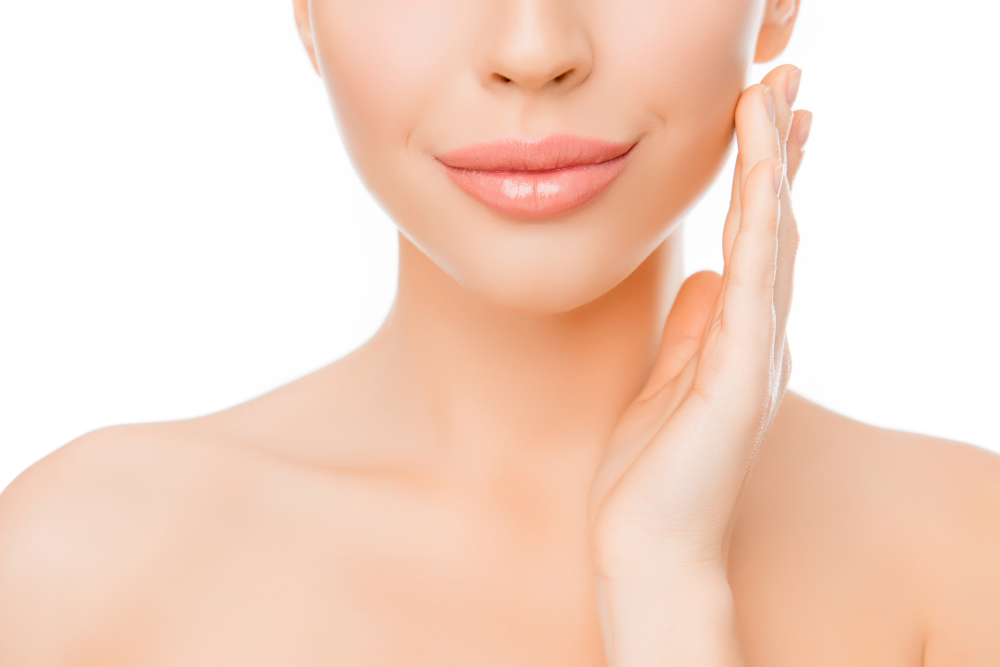Pain or stiffness when you chew may be a sign of masseter muscle or temporomandibular joint disorder (TMD). You may not think of visiting a dermatologist to address these concerns, but by using Botox injections, your dermatologist may be able to alleviate symptoms related to TMD as well as slim the jawline. According to Dr. Emily Clarke of U.S. Dermatology Partners Austin – Mueller, “Botox has been popular to prevent signs of skin aging like wrinkles and fine lines, but many people don’t know it’s also a treatment for certain muscle dysfunction. Many providers use Botox off-label to help with masseter muscle enlargement or even symptoms from temporomandibular disorder (TMD).” In this blog, Dr. Clarke answers some frequently asked questions, including what is masseter muscle Botox and how does it benefit people with jaw pain from TMD?
What Is Masseter Muscle Botox?
One of the strongest muscles in the body, the masseter muscle, is located on the back of the jaw. It’s the muscle that controls closing of the jaw as you speak and chew. When the masseter muscle is overused, often due to teeth grinding or jaw clenching (also called bruxism), it can become enlarged and cause pain or stiffness. Additionally, these movements may strain or damage the temporomandibular joint (TMJ) over time. The results of TMD include jaw pain, stiffness, dental wear, uneven bite, chronic headaches, and a square-shaped jawline due to muscle enlargement.
Masseter muscle Botox is a non-invasive treatment option that may alleviate discomfort associated with chronic bruxism or TMD in some patients. It involves placing injections of botulinum toxin (Botox) into the masseter muscle to reduce unconscious muscle movement and relax the enlarged or tightened muscles. According to Dr. Clarke, “Botox has become well-known for its role in anti-aging and aesthetics, but Botox was actually initially developed for muscle disorders before its cosmetic applications were discovered. Off-label use of Botox for symptom relief and cosmetic improvement may be a helpful adjunctive treatment for TMD and masseter enlargement.”
How Does It Work?
To move muscles, the brain sends a message to the muscles through nerves. Botox works by blocking the signals between nerves and muscles, which relaxes the muscles so they can’t tighten or contract as much. When the muscle relaxes, it may alleviate pain and stiffness associated with TMD and reduce the muscle size. Masseter muscle Botox is performed by placing injections in the thickest part of the masseter muscle on each side of the jawline. Over time, the reduced muscle movement also provides an additional benefit of slimming the jawline for a more aesthetic appearance.
TMD Relief + Cosmetic Contouring: A Dual Benefit
According to Dr. Clarke, “As a dermatologist, I regularly utilize Botox to reduce wrinkles and fine lines, but many people don’t think about visiting their dermatologist for off-label Botox injections for TMD relief. Not only can Botox reduce jaw pain and stiffness related to TMD in some patients, but it also has the added benefit of slimming the jawline, especially when the masseter muscle has enlarged from chronic overuse. I think it’s very important to work with a professional who has experience in safe and effective Botox injection technique. The correct dose and injection placement is essential to achieve the desired results, especially if wanting to receive the most benefit from masseter Botox.”
Medical Benefit: TMD Symptom Relief
TMD refers to issues affecting the TMJ and muscles that connect your jawbone to the skull. This can sometimes be caused by chronic grinding of the teeth or clenching of the jaw, also called bruxism, which is a result of masseter muscle activation. Symptoms include jaw pain, stiffness, clicking or popping sounds, earaches, headaches, facial pain, or difficulty chewing. TMD relief may be a benefit of off-label masseter muscle Botox, which can be used as a helpful adjunct to other traditional TMD treatments.
Cosmetic Benefit: Slimmer, V-Shaped Jawline
Continual or chronic jaw movements caused by bruxism lead to a bulkier masseter muscle. Enlargement of the masseter muscle can also cause a square-shaped jawline, which is a particularly noticeable change for those with a naturally narrower or heart-shaped face. Botox injections reduce masseter muscle thickness for a tapered and more feminine jawline.
Who Is a Good Candidate for Masseter Botox?
Masseter Botox may be a good off-label aesthetic or adjunctive symptom-relieving solution for patients, including those:
- Diagnosed with TMD or bruxism.
- Experiencing chronic jaw pain or other symptoms from TMD.
- Looking to slim their jawline.
Patients Who May Not Benefit from Masseter Muscle Botox
While masseter Botox is beneficial for many, it may not be recommended for those who are:
- Pregnant or breastfeeding.
- Dealing with active skin infections.
- Allergic to botulinum toxin.
- Suffering from neuromuscular disorders.
Why Rely on Dermatologists for Masseter Botox
Many people seek Botox from med spas or other less practiced providers, but dermatologists have the knowledge and qualifications necessary to provide this off-label bruxism treatment safely and effectively. Some of the benefits of working with a dermatologist for masseter Botox include:
- Facial anatomy expertise – dermatologists provide cosmetic treatments that impact facial structures daily, so they understand how to correctly place Botox injections for optimal results.
- Balanced medical and cosmetic goals – dermatologists frequently provide both cosmetic and medical care. They understand the importance of balancing these two factors and take a holistic approach to treatment.
- Customization – with comprehensive experience using Botox and other neurotoxins, dermatologists understand how to precisely place masseter muscle injections, what dosage to use, and how many injections are needed. They customize each treatment to ensure optimal results based on individual patient goals.
- Safety – as medical professionals, dermatologists recognize potentially adverse effects and complications of cosmetic treatments, taking an approach to discuss and minimize these before they occur. Dermatologists possess the appropriate training and knowledge to provide masseter Botox injections safely.
What to Expect During and After Treatment
Below, Dr. Clarke outlines the basic process of receiving Botox and maintaining the results.
- Preparatory visit – during your consultation session, the dermatologist evaluates your symptoms, discusses treatment options, reviews risks and benefits of treatment, and schedules a treatment session if applicable.
- Treatment – after cleaning the injection site, the dermatologist precisely places injections on each side of the jaw into the masseter muscles. Masseter Botox injections are usually completed from start to finish within minutes.
- Aftercare – avoid lying flat for a few hours after treatment and don’t engage in strenuous exercise, apply pressure, or massage the treatment area for the first 24 hours. Most side effects are mild, such as minor bruising, tenderness, or slight bleeding at the injection site. Less common effects can include temporary muscle weakness, changes in muscle size, facial asymmetry, or even alterations in the underlying bone with repeated treatment. You should promptly inform your healthcare provider if you experience significant bruising, swelling, prolonged bleeding, persistent weakness, or unusual tenderness. If you notice signs of infection or any serious reaction, seek medical attention right away.
- Maintenance visits – many patients receive Botox injections at regular intervals, which may be necessary to maintain these results. Your dermatologist will establish an appropriate treatment regimen and frequency with you at your visit.
When to See a Dermatologist
A dermatologist can evaluate your symptoms and help you develop a plan to alleviate TMD pain and slim the jawline, which may involve off-label masseter Botox. If Botox is not the right solution, your dermatologist can provide guidance to help you achieve your individual goals. Your dermatologist can also work with other health professionals to provide multidisciplinary treatments for TMD including lifestyle changes, stress reduction, mindfulness, and bite guards or splints, just to name a few.
Conclusion: Experience the Dual-Benefit of Masseter Botox
In conclusion, Dr. Clarke says, “If you are experiencing symptoms from TMD or desiring a slimmer jawline, consider scheduling a dermatology consultation to determine if off-label masseter Botox may be right for you.”
Schedule a Masseter Muscle Botox Consultation
Whether you’re curious about masseter muscle Botox or you want to improve skin health or appearance, it’s time to schedule a consultation with a knowledgeable dermatologist. At U.S. Dermatology Partners, we make it simple and straightforward to schedule a visit with one of our local dermatology teams. Take just a moment to request a visit using our online scheduling form.
Find a location near me
or


